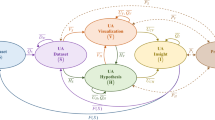Abstract
Data is a powerful tool to make informed decisions. They can be used to design products, to segment the market, and to design policies. However, trusting so much in data can have its drawbacks. Sometimes a set of indicators can conceal the reality behind them, leading to biased decisions that could be very harmful to underrepresented individuals, for example. It is challenging to ensure unbiased decision-making processes because people have their own beliefs and characteristics and be unaware of them. However, visual tools can assist decision-making processes and raise awareness regarding potential data issues. This work describes a proposal to fight biases related to aggregated data by detecting issues during visual analysis and highlighting them, trying to avoid drawing inaccurate conclusions.
Access this chapter
Tax calculation will be finalised at checkout
Purchases are for personal use only
Similar content being viewed by others
References
Sweeney, L.: Discrimination in online ad delivery. arXiv preprint arXiv:1301.6822 (2013)
Garcia, M.: Racist in the machine: the disturbing implications of algorithmic bias. World Policy J. 33, 111–117 (2016)
Hajian, S., Bonchi, F., Castillo, C.: Algorithmic bias: from discrimination discovery to fairness-aware data mining. In: Proceedings of the 22nd ACM SIGKDD International Conference on Knowledge Discovery and Data Mining, pp. 2125–2126. ACM (2016)
Keim, D.A., Andrienko, G., Fekete, J., Görg, C., Kohlhammer, J., Melançon, G.: Visual analytics: definition, process, and challenges. In: Kerren, A., Stasko, J., Fekete, J., North, C. (eds.) Information Visualization, pp. 154–175. Springer, Heidelberg (2008)
Thomas, J.J., Cook, K.A.: Illuminating the path: the research and development agenda for visual analytics. National Visualization and Analytics Center, USA (2005)
Munzner, T.: Visualization Analysis and Design. AK Peters/CRC Press, Boca Raton (2014)
Harrison, L., Yang, F., Franconeri, S., Chang, R.: Ranking visualizations of correlation using weber’s law. IEEE Trans. Visual Comput. Graph. 20, 1943–1952 (2014)
O’Neil, C.: On Being a Data Skeptic. O’Reilly Media, Inc., Newton (2013)
Patil, D., Mason, H.: Data Driven. O’Reilly Media Inc, Newton (2015)
Shah, S., Horne, A., Capellá, J.: Good data won’t guarantee good decisions. Harvard Bus. Rev. 90, 23–25 (2012)
Bonneau, G.-P., Hege, H.-C., Johnson, C.R., Oliveira, M.M., Potter, K., Rheingans, P., Schultz, T.: Overview and state-of-the-art of uncertainty visualization. In: Scientific Visualization, pp. 3–27. Springer, Heidelberg (2014)
Brodlie, K., Osorio, R.A., Lopes, A.: A review of uncertainty in data visualization. In: Expanding the Frontiers of Visual Analytics and Visualization, pp. 81–109. Springer, Heidelberg (2012)
Anscombe, F.J.: graphs in statistical analysis. Am. Stat. 27, 17–21 (1973)
Pollet, T.V., Stulp, G., Henzi, S.P., Barrett, L.: Taking the aggravation out of data aggregation: a conceptual guide to dealing with statistical issues related to the pooling of individual-level observational data. Am. J. Primatol. 77, 727–740 (2015)
Kramer, G.H.: The ecological fallacy revisited: aggregate-versus individual-level findings on economics and elections, and sociotropic voting. Am. Polit. Sci. Rev. 77, 92–111 (1983)
Piantadosi, S., Byar, D.P., Green, S.B.: The ecological fallacy. Am. J. Epidemiol. 127, 893–904 (1988)
Blyth, C.R.: On Simpson’s paradox and the sure-thing principle. J. Am. Stat. Assoc. 67, 364–366 (1972)
Wagner, C.H.: Simpson’s paradox in real life. Am. Stat. 36, 46–48 (1982)
Perez, C.C.: Invisible Women: Exposing Data Bias in a World Designed for Men. Random House, New York (2019)
Alipourfard, N., Fennell, P.G., Lerman, K.: Can you trust the trend?: discovering Simpson’s paradoxes in social data. In: Proceedings of the Eleventh ACM International Conference on Web Search and Data Mining, pp. 19–27. ACM (2018)
Xu, C., Brown, S.M., Grant, C.: Detecting Simpson’s paradox. In: The Thirty-First International Flairs Conference (2018)
Guo, Y., Binnig, C., Kraska, T.: What you see is not what you get!: detecting Smpson’s paradoxes during data exploration. In: Proceedings of the 2nd Workshop on Human-In-the-Loop Data Analytics, p. 2. ACM (2017)
Bickel, P.J., Hammel, E.A., O’Connell, J.W.: Sex bias in graduate admissions: data from Berkeley. Science 187, 398–404 (1975)
Nickerson, R.S.: Confirmation bias: a ubiquitous phenomenon in many guises. Review of general psychology 2, 175–220 (1998)
Hullman, J., Adar, E., Shah, P.: The impact of social information on visual judgments. In: Proceedings of the SIGCHI Conference on Human Factors in Computing Systems, pp. 1461–1470. ACM (2011)
Kim, Y.-S., Reinecke, K., Hullman, J.: Data through others’ eyes: the impact of visualizing others’ expectations on visualization interpretation. IEEE Trans. Visual Comput. Graph. 24, 760–769 (2018)
Mills, E.: ‘Leave No One Behind’: Gender, Sexuality and the Sustainable Development Goals. IDS (2015)
Stuart, E., Samman, E.: Defining “leave no one behind”. ODI Briefing Note. London: ODI (www.odi.org/sites/odi.org.uk/files/resource-documents/11809.pdf) (2017)
Abualghaib, O., Groce, N., Simeu, N., Carew, M.T., Mont, D.: Making visible the invisible: why disability-disaggregated data is vital to “leave no-one behind”. Sustainability 11, 3091 (2019)
Rice, L., Barth, J.M.: Hiring decisions: the effect of evaluator gender and gender stereotype characteristics on the evaluation of job applicants. Gend. Issues 33, 1–21 (2016)
Alford, H.L.: Gender bias in IT hiring practices: an ethical analysis (2016)
Acknowledgments
This research work has been supported by the Spanish Ministry of Education and Vocational Training under an FPU fellowship (FPU17/03276). This work has been partially funded by the Spanish Government Ministry of Economy and Competitiveness throughout the DEFINES project (Ref. TIN2016-80172-R) and the Ministry of Education of the Junta de Castilla y León (Spain) throughout the T-CUIDA project (Ref. SA061P17).
Author information
Authors and Affiliations
Corresponding author
Editor information
Editors and Affiliations
Rights and permissions
Copyright information
© 2020 The Editor(s) (if applicable) and The Author(s), under exclusive license to Springer Nature Switzerland AG
About this paper
Cite this paper
Vázquez-Ingelmo, A., García-Peñalvo, F.J., Therón, R. (2020). Aggregation Bias: A Proposal to Raise Awareness Regarding Inclusion in Visual Analytics. In: Rocha, Á., Adeli, H., Reis, L., Costanzo, S., Orovic, I., Moreira, F. (eds) Trends and Innovations in Information Systems and Technologies. WorldCIST 2020. Advances in Intelligent Systems and Computing, vol 1161. Springer, Cham. https://doi.org/10.1007/978-3-030-45697-9_40
Download citation
DOI: https://doi.org/10.1007/978-3-030-45697-9_40
Published:
Publisher Name: Springer, Cham
Print ISBN: 978-3-030-45696-2
Online ISBN: 978-3-030-45697-9
eBook Packages: Intelligent Technologies and RoboticsIntelligent Technologies and Robotics (R0)




